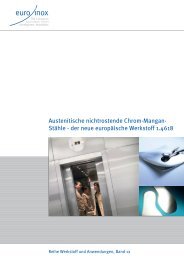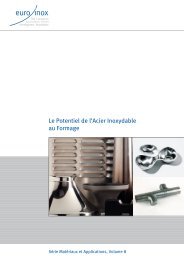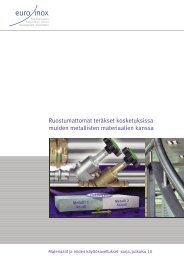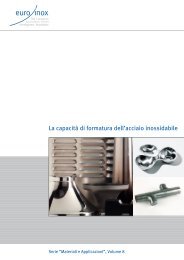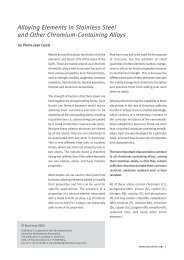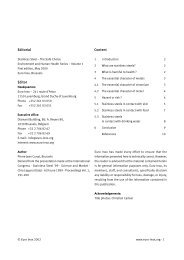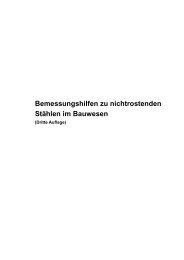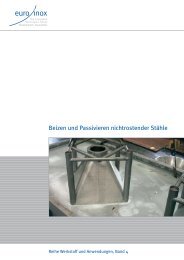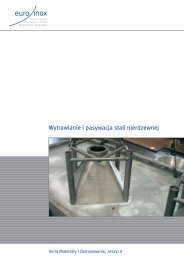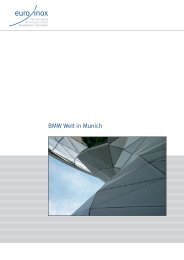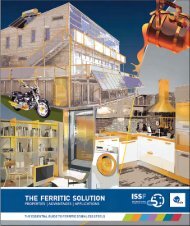Innovative Stainless Steel Applications in transport ... - Euro Inox
Innovative Stainless Steel Applications in transport ... - Euro Inox
Innovative Stainless Steel Applications in transport ... - Euro Inox
Create successful ePaper yourself
Turn your PDF publications into a flip-book with our unique Google optimized e-Paper software.
material strengths or manufactur<strong>in</strong>g routes, from a load-bear<strong>in</strong>g po<strong>in</strong>t of view. The<br />
practical structural properties are stiffness-dependant (i.e. geometry-dependent). The<br />
differences <strong>in</strong> panel type (O- or Vf-type), material strength (e.g. a high-strength grade)<br />
or assembly method (e.g. discont<strong>in</strong>uous welds, adhesive bond<strong>in</strong>g) only become evident<br />
at loads and result<strong>in</strong>g displacements that are far beyond acceptable for any floor<br />
structure – apart from exceptional impact-load situations, such as crash or collision.<br />
Thus, choice between panel details has to be based on weigh<strong>in</strong>g up other factors, such<br />
as: the advantages of us<strong>in</strong>g standard RHS tube cores rather than tailored sheet Vfprofiles<br />
aga<strong>in</strong>st the punishment <strong>in</strong> panel weight, or the smooth and <strong>in</strong>tact sheet surfaces<br />
atta<strong>in</strong>able by adhesive bond<strong>in</strong>g aga<strong>in</strong>st <strong>in</strong>creased panel-assembly time, or the improved<br />
stiffness characteristics of a V-type panel <strong>in</strong> bend<strong>in</strong>g aga<strong>in</strong>st extensive difficulties <strong>in</strong><br />
panel manufacture and assembly.<br />
In static longitud<strong>in</strong>al tests, global buckl<strong>in</strong>g is the major failure mode, while <strong>in</strong> the crash<br />
tests local buckl<strong>in</strong>g at the end of the panels is the major failure mode, leav<strong>in</strong>g the<br />
middle of the panel almost without significant, irreversible (lateral) deformation. The<br />
lack of lateral deformation and the fact that crumpl<strong>in</strong>g is only at the ends leaves the<br />
passenger region quite unharmed. This is the most favourable condition that can be<br />
desired for a passenger compartment, <strong>in</strong> terms of crashworth<strong>in</strong>ess.<br />
In transverse tests, the buckl<strong>in</strong>g mode for both static and crash test show more similar<br />
features. The panel showed more widespread plastic deformation, clearly visible <strong>in</strong> the<br />
large lateral deformation. These large lateral displacements would be transmitted to the<br />
passengers <strong>in</strong> this region, giv<strong>in</strong>g them the first primary shock load. Also, the amount of<br />
elastic energy stored <strong>in</strong> a sideways collision is considerable. Beside the large lateral<br />
displacements <strong>in</strong> the panel, elastic deformation can be released from the structure after<br />
the <strong>in</strong>itial impact, result<strong>in</strong>g <strong>in</strong> a secondary shock load <strong>in</strong>flicted on the passenger <strong>in</strong> the<br />
crumpled region.<br />
The maximum energy absorption could not be established <strong>in</strong> the crash test facility. Both<br />
mass and velocity were limited, but it is plausible that a longitud<strong>in</strong>al panel can absorb<br />
significantly more energy than could be tested for. In general, all panels performed quite<br />
similarly <strong>in</strong> the longitud<strong>in</strong>al tests. In the transverse tests, the O-core panels dissipate<br />
about 25 % less energy compared to the Vf-core.<br />
101



